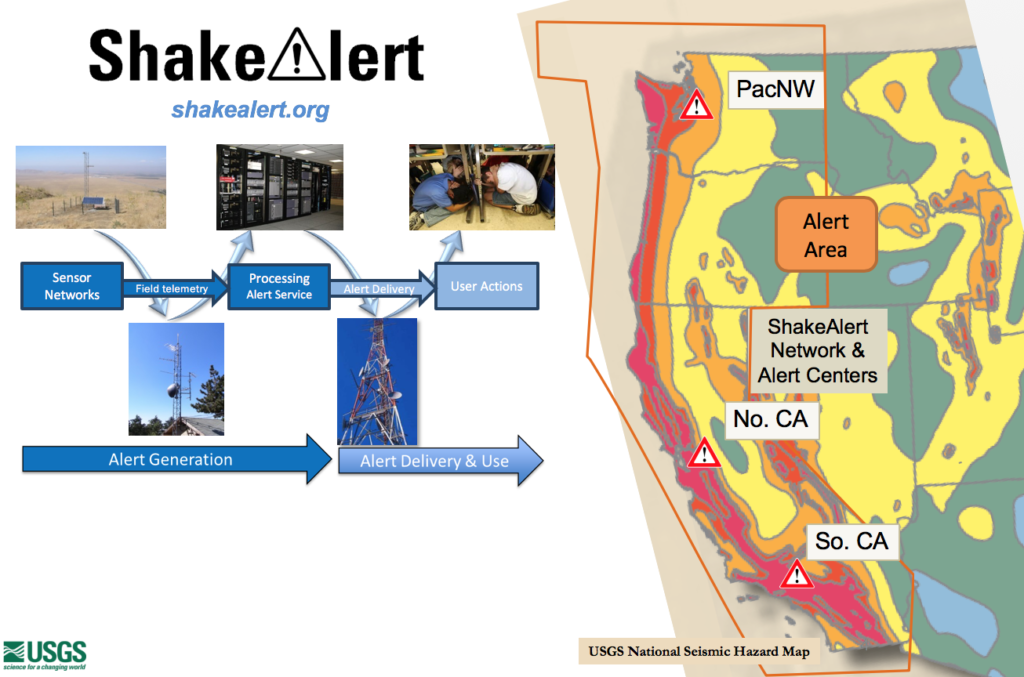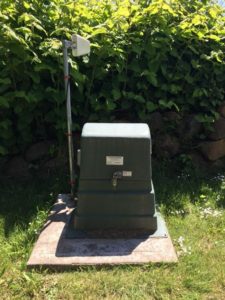
By DANA TIMS/YachatsNews.com
Starting next month, thanks to a multi-state program years in development, Oregon residents will receive cell phone alerts to brace for an impending earthquake.
The ShakeAlert Earthquake Early Warning system will give Oregonians anywhere from five seconds to tens of seconds notice that a quake of at least 5.0 magnitude is about to strike.
The state of California’s ShakeAlert system has been “live” since Oct. 17, 2019. Now, with enough earthquake sensors on line here to activate the system, Oregon residents on March 11 will get a similar heads-up.
“Even a few years ago, we thought it might be anywhere from 20 to 25 years before the system in Oregon could be functional,” said Leland O’Driscoll, program manager at the Oregon Hazards Lab at the University of Oregon, which is helping guide oversight of Oregon’s piece of the operation. “That changed quickly because we kept hitting the bar with funding.”

The state currently has 125 contributing sensors, which are strategically located along the coast and on known fault zones in both the Willamette Valley and parts of southern and eastern Oregon. One of those sensors is located on a hillside in Yachats near one of the city’s water reservoirs.
At full build-out, in two years, Oregon will have 250 of the system’s 1,675 seismic stations. The state of Washington’s piece of the system is expected to rollout in May.
The U.S. Geological Survey, working with a variety of state and university partners, has been spearheading the ShakeAlert system.
The system’s sensors collect and share real-time information about the magnitude, location and expected shaking, O’Driscoll said. The system’s distribution partners then deliver alerts to citizens via cell phone and the internet, similar to how Amber alerts are automatically sent to cell phones after an abduction has been reported.
One mobile app that people can also download to their phones, QuakeAlertUSA, is currently available in Oregon.
Messages are also available to ShakeAlert distribution partners such as utilities, hospitals, transportation systems, schools, emergency management agencies to trigger automated actions such as closing water valves, starting back-up generators and issuing public announcements. For a ShakeAlert message to be issued by the USGS, at least four seismic sensors need to detect the same ground motion.
People receiving ShakeAlert messages will be advised to find secure cover in their own residences rather than, saying fleeing outside.
“The danger of building collapse makes it far safer to remain in place, at least until the shaking stops,” O’Driscoll said. “And once it does, depending on how long the shaking took place, people will need to go into their second plan of action. Because we also know that once a quake comes through, especially along the coast, expect a tsunami to hit next.”
Rep. David Gomberg, D-Otis, has been outspoken in his advocacy for completing the system’s Oregon piece. He applauded the March 11 rollout and advised that any lead time at all in knowing a quake is coming could save lives.

“It gives enough warning to find your kids, to turn off your gas, to collect enough thoughts that you aren’t caught reacting with absolutely no warning,” Gomberg said. “That’s all the difference in the world.”
Gomberg and other system advocates were disappointed a year ago when Senate Bill 1537, which included the earthquake warning system and other emergency preparedness measures, died during the Oregon Legislature’s 35-day “short session.” It marked the second straight session where a bill with money to complete the system failed.
Things turned around dramatically last August, when the Legislature approved $7.5 million to fund Oregon’s system during their one-day special session.
“I’m really pleased to see this moving to implementation,” Gomberg said. “It’s long overdue.”
Locally, the Central Lincoln Public Utility District has worked to help locate seven quake sensors at its various substations along the coast.
Randy Grove, the utility’s general manager, has been supportive throughout the process, saying, “The technology is proven. It works well. The consortium needed secure places on the coast to locate sensors, and we could provide those spaces.”
The March 11 delivery date coincides with the 10th anniversary of the magnitude-9.1 Great Tohoku earthquake in Japan, which killed about 20,000 people, according to a U.S.G.S statement. The quake’s ensuing tsunami generated waves up to 132 feet high and caused the meltdown of three nuclear reactors at the Fukushima Daiichi Nuclear Power Plant.
“The more time we have to prepare for these sorts of emergencies, the better off we’ll all be,” the UO’s O’Driscoll said. “This is definitely a positive step forward.”


